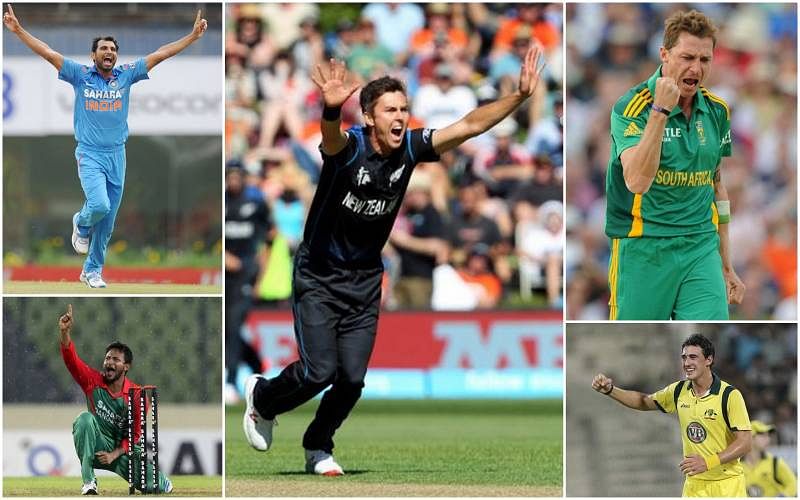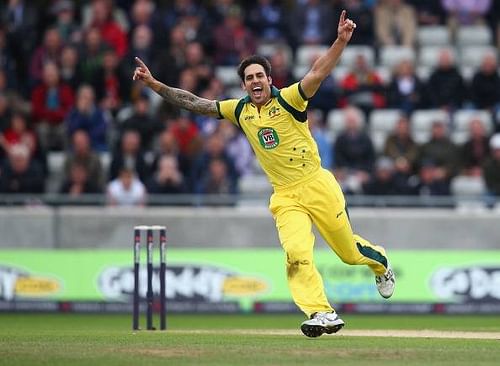
Who is the greatest match-winner among current ODI bowlers?

“Part of the art of bowling spin is to make the batsman think something special is happening when it isn’t.” – Shane Warne.
Warnie, one of the greatest match-winning bowlers ever, spoke the quintessential truth not just about spinners but about every bowler who has held the red or white cherry in his hands. If Wasim Akram and Waqar Younis could make the ball talk more than a domesticated parrot, Glenn McGrath would prey on the batsmen’s impatience, hunting them with his steadfast, machine-like consistency.
The recently concluded World Cup gave us an idea about the current crop of fast bowlers and how they perform under pressure. How many factors do we need to look at before we call one ODI bowler better than the other? In ODIs, with constantly changing rules, bigger bats and smarter innovations in stroke-making, the wickets you take or runs you concede always paint a scrambled picture.
The great novelist Mark Twain said, “Facts are stubborn things, but statistics are pliable.” So could we look deeper into them, into multiple combinations of stats that could illuminate us about the bowlers who took wickets and saved runs when it mattered most? Is it possible to separate bowlers based on the wickets they ensnared, the quality of the wickets and the quality of the opposition?
Question 1: What would be a good time-frame to judge the bowlers?
While for batsmen three to five years is a good time-frame, we cannot really say so in case of bowlers. Two years is the maximum across which we judge a bowler for his match-winning value, for two simple reasons – the effects of the changing rules and the vulnerability to injuries.
A good example would be Lasith Malinga and his effectiveness before and after his surgery complemented by bowlers’ stats after the introduction of the ‘two new balls’ rule. A list of the world’s top ODI bowlers indicates that there is much difference based on a two-year or a single year time frame.
However, some teams like Australia have played far fewer games in the last one year compared to Sri Lanka or India, which means that the sample size is not big enough to judge a bowler’s match winning ability.
Question 2: What attributes would be ideal to compare match-winning ODI bowlers?
So here are a few attributes we could look at when we separate match-winners from the above-average strata of bowlers:
– Bowling average versus team’s bowling average across two years. This shows how far ahead the bowler is from the rest of the pack playing in his team. Bigger the difference, more the significance of the bowler.
– Economy rate versus team’s overall economy rate across two years. This shows how the bowler fares in conceding runs vis-à-vis the rest of the bowlers. The best bowlers help other bowlers too by restricting runs and increasing pressure which results in wickets – a selfless way of contributing to the team’s cause.
– The average, economy rate and wickets taken by the bowler in matches won by his team. This could show how important a bowler is to his team’s chances. Great match-winners often produce scintillating match-winning performances and when they don’t, their team almost invariably loses.
– Percentage of good games. This could be a little abstract. But let’s ask ourselves what match-winners do. Bowl brilliantly economic spells even if they don’t take wickets or wreck the opposition by taking wickets even if they concede some runs? Given the present scenario, a bowler who has taken at least three wickets could fall into that category.
– With the new rules and scrambled stats mixed with Duckworth Lewis, it is hard to pick an economy rate that is not contextual and offers absolute truth. Although not an entirely conclusive stat on its own, it can give us an idea of how often the bowler makes a telling contribution.
– Lastly, the best match-winners have a low economy rate and a low bowling average. In ODIs, a bowler who takes wickets is just as valuable as one who concedes less. A bowler who does both though, is invaluable. So, a coefficient obtained by multiplying economy rate and average is a stat that will highlight the bowlers who don’t top either list but are still crucial.
Let the comparisons begin!
Overall record across last two years
There are a total of 40 bowlers who have taken more than 30 wickets in the last two years. Change the threshold to 40 wickets and we get just 23 bowlers – still too big a list for us to process.
Let us add a couple of other parameters. Let us take bowlers who have either an average of less than 25 or an economy rate of less than 5. That number crosses 20 as well, with a lot of bowlers like Ravichandran Ashwin, James Tredwell, Mohammad Irfan and Bhuvneshwar Kumar going at economy rates between 4.5 and 5.
Only five bowlers have an economy of less than 4.5 and all of them have an average way below 25. It’s safe to assume then that our match-winners are bowlers with –
- Average < 25
- Wickets taken in last two years > 30
Of these, Saeed Ajmal and Ajantha Mendis are two redundant entries considering they’ve fallen off the radar over the last six months. But if we take a look at that list we note that there are few real match-winners who stand out.
For the sake of convenience to compare other stats, we will have to prune our list further. Ajmal and Mendis miss out because of their dwindling significance in recent times. Corey Anderson misses out because of a high economy rate of over 6 and a lower wickets/innings ratio. Vernon Philander misses out because of high injury concerns and a much lower sample size of games played over the last one year – 15.
That leaves us with 10 bowlers – seven pace bowlers and three spinners. That’s enough evidence to say that in the modern game, there are more watch-winning pace bowlers than spin bowlers.
We also need to talk about two special cases – Ravindra Jadeja and Lasith Malinga, who have 48 and 49 wickets in wins respectively in the last two years. In other words, these two bowlers have the biggest dip in their performances when their team loses.
In normal circumstances, that could be a criterion for picking a match-winner.
However, while Jadeja has a bad average, 35, Malinga has a poor economy rate, 5.85. In other words, both the players are below average in losses and over quite a big chunk of games. When they don’t have a good game, they have a bad game – no half-measures. For example, Malinga has just eight wickets in 16 lost games. That is sufficient evidence to rule out the two players.
Suranga Lakmal and Ravichandran Ashwin, over the last two years, are two more players with similar dips. Thus, we arrive at the following list.
|
Name |
Innings |
Maiden Overs |
Wickets |
Average |
Economy Rate |
Wickets/ Innings |
Number of 4+ wicket hauls |
|---|---|---|---|---|---|---|---|
|
Mohammed Shami (India) |
40 |
20 |
83 |
23.18 |
5.61 |
2.025 |
5 |
|
M Morkel (SA) |
37 |
19 |
65 |
24.81 |
4.95 |
1.9 |
1 |
|
DW Steyn (SA) |
31 |
23 |
60 |
19.61 |
4.57 |
1.9 |
3 |
|
Imran Tahir (SA) |
32 |
13 |
56 |
22.96 |
4.43 |
1.75 |
4 |
|
MG Johnson (Aus) |
29 |
18 |
48 |
24.91 |
4.86 |
1.65 |
3 |
|
MA Starc (Aus) |
22 |
13 |
46 |
17.06 |
4.41 |
2.08 |
5 |
|
UT Yadav (India) |
25 |
10 |
44 |
23.9 |
5.49 |
1.76 |
3 |
|
TA Boult (NZ) |
19 |
21 |
40 |
20.55 |
4.56 |
2.1 |
4 |
|
Shakib Al Hasan (Ban) |
24 |
10 |
37 |
23.78 |
4.27 |
1.5 |
2 |
|
HMRKB Herath (SL) |
24 |
8 |
35 |
24.02 |
4.49 |
1.4 |
1 |

|
Name |
Bowling average of bowler |
Bowling average of team |
Bowling average of bowler in wins |
Bowling average of team in wins |
|---|---|---|---|---|
|
MA Starc (Aus) |
17.06 |
30.49 |
17.6 |
26.21 |
|
DW Steyn (SA) |
19.61 |
26.4 |
17.04 |
20.87 |
|
TA Boult (NZ) |
20.55 |
32.44 |
18.2 |
27.23 |
|
Imran Tahir (SA) |
22.96 |
26.4 |
18.58 |
20.87 |
|
Mohammed Shami (Ind) |
23.18 |
30.85 |
19.47 |
24.47 |
|
Shakib Al Hasan (Ban) |
23.78 |
32.38 |
22 |
25.25 |
|
UT Yadav (India) |
23.9 |
30.85 |
19.91 |
24.47 |
|
HMRKB Herath (SL) |
24.02 |
33.66 |
19.86 |
24.34 |
|
M Morkel (SA) |
24.81 |
26.4 |
21.86 |
20.87 |
|
MG Johnson (Aus) |
24.91 |
30.49 |
15.31 |
26.21 |
A lot of statisticians make a basic blunder here; they pick match-winners based on how much extra they contribute to the team’s wins. By that count, the difference in performance will be highest in case of Malinga, like we had discussed earlier.
The above table shows why Australia and New Zealand played the World Cup final; they have match-winners of specific types.
Mitchell Starc – There is hardly any difference in the bowling average of Mitchell Starc in wins and losses. In other words, Starc is extremely consistent and rarely has a bad day, which is what makes him so dangerous.
Mitchell Johnson – On his day, Johnson is even better than Starc, his average the lowest amongst our match-winning bowlers in wins. Yet, there is a drop of more than nine points in his average between all games and wins alone.
Trent Boult – Along with the two above, Boult registers the biggest difference of average in wins.
So unlike what most statisticians conclude, you cannot say really that Johnson is the bigger match-winner because his performances peak in Australia’s wins. Given a choice, you would rather pick Boult and Starc over Johnson, although of course it doesn’t hurt to have Johnson playing alongside the two left-armers.